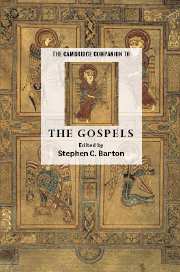Book contents
- Frontmatter
- Introduction
- Part I Approaching the gospels: context and method
- 1 What is a gospel?
- 2 The fourfold gospel
- 3 The canonical matrix of the gospels
- 4 The gospels and ‘the historical Jesus’
- 5 The gospels and the reader
- Part II The gospels as witnesses to Christ: content and interpretation
- Part III The afterlife of the gospels: impact on church and society
5 - The gospels and the reader
from Part I - Approaching the gospels: context and method
Published online by Cambridge University Press: 28 January 2007
- Frontmatter
- Introduction
- Part I Approaching the gospels: context and method
- 1 What is a gospel?
- 2 The fourfold gospel
- 3 The canonical matrix of the gospels
- 4 The gospels and ‘the historical Jesus’
- 5 The gospels and the reader
- Part II The gospels as witnesses to Christ: content and interpretation
- Part III The afterlife of the gospels: impact on church and society
Summary
From at least the eighteenth to the mid-twentieth century the prevailing understanding of history and of texts and their meaning was almost exclusively object-centred. The reader of the text seldom came into view, and if she or he did, the exegesis was suspect. History was understood as a free-standing state of affairs which existed 'in the past' independently of the reader. Texts were free-standing semantic containers in which a single, stable meaning was intentionally embedded by the author. The meaning in the biblical texts was presumed to be primarily information about history. Thus, the task of the biblical scholar was primarily if not exclusively to extract from the text what it had to say about history. The primary concern was, at first, to discover 'what really happened' in the past; for instance, who Jesus really was and what he really said and did. Gradually, as source criticism gave rise to redaction criticism in gospel scholarship, the interest shifted to what each evangelist contributed to the presentation of this historical material and how that contribution both influenced the data about Jesus and his message (e.g., through selection and emphases) and gave the reader access to another sphere of historical data, viz., the Sitz im Leben or the community context in which the oral tradition about Jesus was transmuted through practice into text. However, the interest still focused on the information that was embedded in the text, either explicitly or implicitly. The ideal was still historical objectivity, but now less focused on 'what really happened' and more on 'what the author intended to say' about what really happened.
- Type
- Chapter
- Information
- The Cambridge Companion to the Gospels , pp. 97 - 118Publisher: Cambridge University PressPrint publication year: 2006

